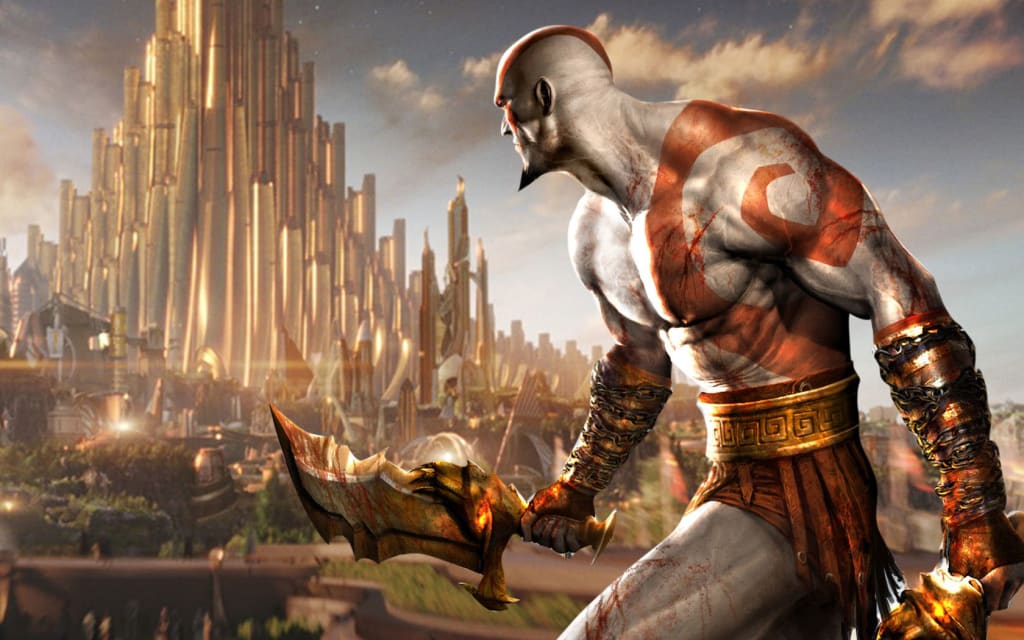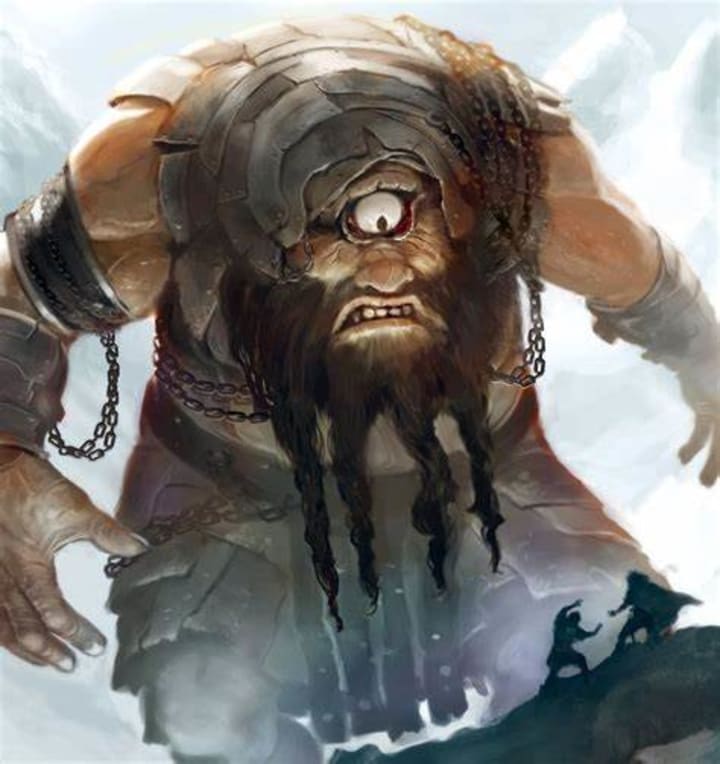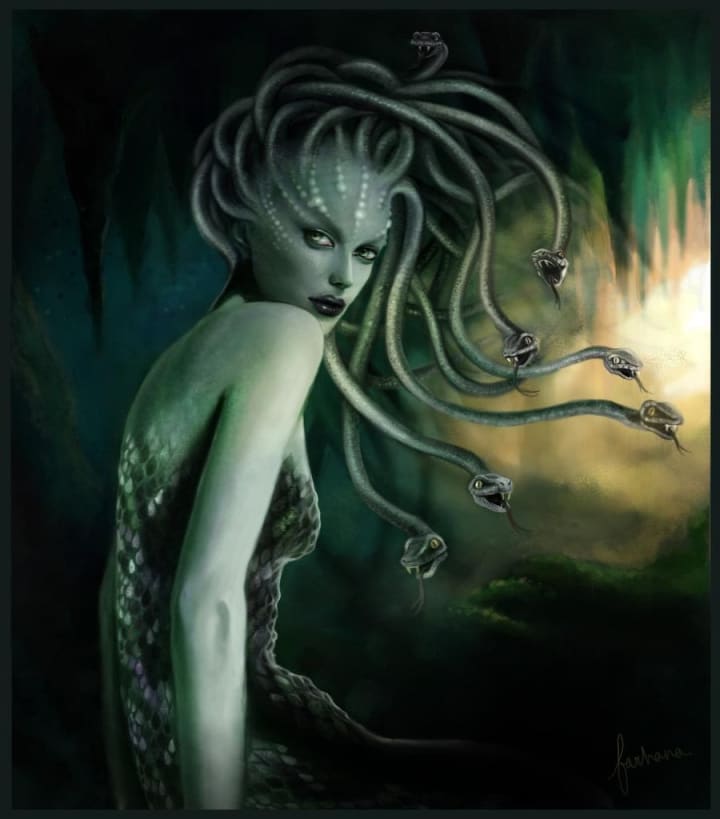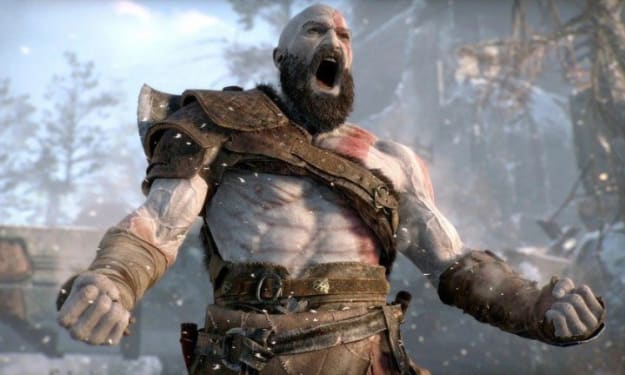5 Mythological creature shown in God of War video game series
Cyclops, Minotaur, Medusa, Valkyries, Jötnar

1., Cyclops:

Cyclops is a famous creature in Greek mythology. Known for its immense size and one eye, the Cyclops was a character featured in various myths and stories. In this article, we will explore the history and story of the Cyclops in Greek mythology.
History of the Cyclops:
The Cyclops is believed to have been first mentioned in Greek literature in Homer's epic poem, The Odyssey. In the poem, the Cyclops is described as a giant with one eye in the center of his forehead. The Cyclops was also later referenced in other works of Greek literature, including Theogony by Hesiod.
In Greek mythology, the Cyclops were often portrayed as a race of giant beings. The Cyclops were known for their immense strength and their ability to craft weapons, including the thunderbolt used by Zeus.
Story of the Cyclops:
The Cyclops feature in many Greek myths and stories, including the story of Odysseus. In this story, Odysseus and his men became trapped in a cave by a Cyclops named Polyphemus. Polyphemus was a son of Poseidon, the god of the sea, and he was angered by Odysseus and his men when they entered his cave and began eating his food.
Polyphemus, being a giant and much stronger than Odysseus and his men, began to eat the men one by one. However, Odysseus managed to devise a plan to escape. He offered Polyphemus wine, which he had brought with him, and when Polyphemus became drunk, he blinded him with a stake. Odysseus and his men then escaped the cave by clinging to the bellies of Polyphemus' sheep.
In another myth, the Cyclops were said to have crafted the weapons of the gods. Zeus, the king of the gods, gave the Cyclops the task of creating thunderbolts for him. The Cyclops were known for their skill in crafting weapons, and they were able to create powerful weapons for the gods.
Conclusion:
The Cyclops is a fascinating and powerful creature in Greek mythology. Known for its immense size and strength, the Cyclops was a prominent character in many Greek myths and stories. Whether as a villain or a craftsman, the Cyclops played an important role in the stories of ancient Greece and continues to captivate readers and audiences to this day.
2., Minotaur:

The Minotaur is a creature from Greek mythology that is depicted as having the head of a bull and the body of a man. In this article, we will explore the history and story of the Minotaur in Greek mythology.
History of the Minotaur:
The Minotaur is believed to have originated from the island of Crete. The creature was first mentioned in Greek literature in the story of Theseus and the Minotaur, which was written by the Greek poet Hesiod. The Minotaur was also referenced in other works of Greek literature, including The Iliad by Homer and The Metamorphoses by Ovid.
Story of the Minotaur:
In the story of Theseus and the Minotaur, the Minotaur is depicted as being held captive in a labyrinth on the island of Crete. Every year, the people of Athens were required to send seven young men and seven young women as a sacrifice to the Minotaur. Theseus, the son of the king of Athens, volunteered to be one of the sacrifices in order to put an end to the sacrifices once and for all.
Upon arriving on the island of Crete, Theseus met Ariadne, the daughter of King Minos, who fell in love with him. Ariadne gave Theseus a ball of string and instructed him to use it to find his way out of the labyrinth after he had killed the Minotaur.
Theseus was able to defeat the Minotaur using his strength and skill. He followed the string back out of the labyrinth, freeing himself and the other Athenians. Theseus then returned to Athens as a hero.
In another story, the Minotaur was created by the wife of King Minos, who had fallen in love with a bull. She asked the god Poseidon for a son who was as strong and fierce as the bull, and he granted her wish by giving her the Minotaur.
Conclusion:
The Minotaur is a fascinating creature in Greek mythology. Known for its strength and ferocity, the Minotaur played an important role in the story of Theseus and continues to captivate readers and audiences to this day. Its unique appearance and origin story make it one of the most iconic creatures in Greek mythology.
3., Medusa:

Medusa is a creature from Greek mythology that is depicted as a woman with snakes for hair and the power to turn people to stone. In this article, we will explore the history and story of Medusa in Greek mythology.
History of Medusa:
Medusa is believed to have originated from ancient Greek mythology. The earliest known depiction of Medusa was on the shield of the Greek hero Perseus, which was created in the 6th century BC. Medusa was later mentioned in various works of Greek literature, including Theogony by Hesiod and the Metamorphoses by Ovid.
Story of Medusa:
In Greek mythology, Medusa was once a beautiful woman who had long, flowing hair. However, she made the mistake of bragging about her beauty, which angered the goddess Athena. As punishment, Athena turned Medusa's hair into snakes and gave her the power to turn people to stone with just one look.
Medusa became a feared creature and was often depicted as being hunted down by heroes. In one of the most famous stories involving Medusa, the hero Perseus was tasked with killing her. He was given a mirrored shield by the goddess Athena, which allowed him to look at Medusa without being turned to stone. He then used his sword to behead her.
After her death, Medusa's head was said to still hold her power to turn people to stone. Perseus used her head as a weapon, holding it up to his enemies to turn them to stone.
Medusa has also been depicted as a victim in some interpretations of Greek mythology. Some stories suggest that she was raped by the god Poseidon in the temple of Athena, leading to her punishment and transformation into a monster.
Conclusion:
Medusa is a fascinating and complex creature in Greek mythology. Known for her striking appearance and deadly powers, Medusa has been depicted as both a villain and a victim in various myths and stories. Her story continues to captivate readers and audiences to this day and she remains one of the most recognizable figures in Greek mythology.
4., Valkyries:

The Valkyries are female figures from Norse mythology who were responsible for selecting which warriors would die in battle and be taken to Valhalla, the hall of Odin. The word "Valkyrie" means "chooser of the slain" in Old Norse.
The origins of the Valkyries are somewhat unclear, but they are believed to have been a part of early Germanic mythology. They are often depicted as beautiful and powerful women, wearing armor and wielding weapons. In some myths, they are depicted as riding horses or flying through the air with wings.
One of the most well-known stories about the Valkyries comes from the Poetic Edda, a collection of Old Norse poems. According to the poem "Helgakvida Hundingsbana I," the hero Helgi was visited by a Valkyrie named Sigrun while he was out hunting. Sigrun told Helgi that she had chosen him to be a great warrior and that he would become king. She also promised to protect him in battle.
In another story, the Valkyries are depicted as serving Odin in his hall of Valhalla. According to Norse mythology, Odin would send out the Valkyries to choose the bravest and most worthy warriors who had died in battle. These warriors would then be taken to Valhalla, where they would feast and fight until the end of the world.
The Valkyries were also believed to have the power to influence the outcome of battles. They could either help their chosen warriors to win or they could cause them to lose. In some myths, they would ride into battle and inspire the warriors with their courage and strength.
In addition to their role as warriors and choosers of the slain, the Valkyries were also associated with fate and prophecy. They were believed to have the ability to see into the future and to know the fate of all people.
The Valkyries have been a popular subject in literature and art for centuries. They have appeared in works by writers such as J.R.R. Tolkien and Neil Gaiman, and have been depicted in paintings, sculptures, and other forms of art.
Overall, the Valkyries remain an important part of Norse mythology and continue to captivate people with their beauty, power, and mystery.
5., Jötnar:

Jötnar are giant supernatural beings in Norse mythology, often seen as enemies of the gods. They are sometimes also referred to as "giants," though the two terms are not exactly interchangeable.
According to Norse mythology, the Jötnar were one of the earliest beings in existence. They were the offspring of the primordial being Ymir, who was created from the elemental forces of fire and ice. The Jötnar were powerful and often depicted as physically imposing, with some possessing magical abilities or control over the elements.
One of the most famous Jötnar in Norse mythology is Loki, who is known for his mischievous and cunning nature. Loki was not originally considered a Jötunn, but rather a god, until it was later revealed that he was actually the son of a Jötunn. He often caused trouble for the gods, but also helped them on occasion.
Another notable Jötunn is Skadi, a giantess who was skilled in skiing and archery. She was forced to marry one of the gods, Njord, as part of a peace treaty, but they were unable to make their marriage work due to their different lifestyles and interests.
One of the most famous stories involving the Jötnar is the tale of Thor's battle with Jörmungandr, the giant serpent who encircles the world. The two clashed in a fierce battle during the events of Ragnarok, the end of the world in Norse mythology.
Despite their often adversarial relationship with the gods, some Jötnar were also capable of forming alliances and even friendships with them. For example, the god Odin was known to have close relationships with several Jötnar, including Mimir, who gave Odin wisdom, and Gunnlod, who guarded the mead of poetry.
About the Creator
Enjoyed the story? Support the Creator.
Subscribe for free to receive all their stories in your feed. You could also pledge your support or give them a one-off tip, letting them know you appreciate their work.






Comments (1)
I really like this series so far. Mainly that's why I'm glad it's available on PC and the price is great in this store: https://royalcdkeys.com/products/god-of-war-steam-cd-key